 English
English



-
 Afrikaans
Afrikaans -
 Albanian
Albanian -
 Amharic
Amharic -
 Arabic
Arabic -
 Armenian
Armenian -
 Azerbaijani
Azerbaijani -
 Basque
Basque -
 Belarusian
Belarusian -
 Bengali
Bengali -
 Bosnian
Bosnian -
 Bulgarian
Bulgarian -
 Catalan
Catalan -
 Cebuano
Cebuano -
 China
China -
 China (Taiwan)
China (Taiwan) -
 Corsican
Corsican -
 Croatian
Croatian -
 Czech
Czech -
 Danish
Danish -
 Dutch
Dutch -
 English
English -
 Esperanto
Esperanto -
 Estonian
Estonian -
 Finnish
Finnish -
 French
French -
 Frisian
Frisian -
 Galician
Galician -
 Georgian
Georgian -
 German
German -
 Greek
Greek -
 Gujarati
Gujarati -
 Haitian Creole
Haitian Creole -
 hausa
hausa -
 hawaiian
hawaiian -
 Hebrew
Hebrew -
 Hindi
Hindi -
 Miao
Miao -
 Hungarian
Hungarian -
 Icelandic
Icelandic -
 igbo
igbo -
 Indonesian
Indonesian -
 irish
irish -
 Italian
Italian -
 Japanese
Japanese -
 Javanese
Javanese -
 Kannada
Kannada -
 kazakh
kazakh -
 Khmer
Khmer -
 Rwandese
Rwandese -
 Korean
Korean -
 Kurdish
Kurdish -
 Kyrgyz
Kyrgyz -
 Lao
Lao -
 Latin
Latin -
 Latvian
Latvian -
 Lithuanian
Lithuanian -
 Luxembourgish
Luxembourgish -
 Macedonian
Macedonian -
 Malgashi
Malgashi -
 Malay
Malay -
 Malayalam
Malayalam -
 Maltese
Maltese -
 Maori
Maori -
 Marathi
Marathi -
 Mongolian
Mongolian -
 Myanmar
Myanmar -
 Nepali
Nepali -
 Norwegian
Norwegian -
 Norwegian
Norwegian -
 Occitan
Occitan -
 Pashto
Pashto -
 Persian
Persian -
 Polish
Polish -
 Portuguese
Portuguese -
 Punjabi
Punjabi -
 Romanian
Romanian -
 Russian
Russian -
 Samoan
Samoan -
 Scottish Gaelic
Scottish Gaelic -
 Serbian
Serbian -
 Sesotho
Sesotho -
 Shona
Shona -
 Sindhi
Sindhi -
 Sinhala
Sinhala -
 Slovak
Slovak -
 Slovenian
Slovenian -
 Somali
Somali -
 Spanish
Spanish -
 Sundanese
Sundanese -
 Swahili
Swahili -
 Swedish
Swedish -
 Tagalog
Tagalog -
 Tajik
Tajik -
 Tamil
Tamil -
 Tatar
Tatar -
 Telugu
Telugu -
 Thai
Thai -
 Turkish
Turkish -
 Turkmen
Turkmen -
 Ukrainian
Ukrainian -
 Urdu
Urdu -
 Uighur
Uighur -
 Uzbek
Uzbek -
 Vietnamese
Vietnamese -
 Welsh
Welsh -
 Bantu
Bantu -
 Yiddish
Yiddish -
 Yoruba
Yoruba -
 Zulu
Zulu
dga test of transformer oil
DGA Test of Transformer Oil An Essential Tool for Asset Management
The Dissolved Gas Analysis (DGA) test of transformer oil is a critical diagnostic tool used in the electrical power industry to assess the condition and reliability of transformers. Transformers play a pivotal role in the transmission and distribution of electrical energy, and their failure can lead to significant operational disruptions and financial losses. Therefore, monitoring the health of transformer oil through DGA testing is essential for effective asset management and risk mitigation.
What is DGA Testing?
DGA involves the analysis of gases dissolved in transformer oil. During normal operation, a transformer generates some amount of heat, which may lead to the thermal breakdown of the insulation materials and oil. This breakdown process produces gases, which can be investigated to provide insights into the transformer’s condition. Common gases detected through DGA testing include hydrogen, methane, ethylene, acetylene, and carbon monoxide, each of which can indicate specific types of faults.
The Importance of DGA Testing
1. Fault Detection The presence of certain gases can indicate developing faults in the transformer. For example, high levels of acetylene might suggest a severe fault due to electrical arcing, whereas elevated levels of hydrogen could indicate thermal overheating. Identifying these issues early through DGA testing allows for timely maintenance and repairs, thus preventing unexpected outages.
2. Trend Analysis Regular DGA testing allows utilities to establish baseline data for transformer operation. By monitoring gas concentrations over time, engineers can detect trends that may point to an increasing risk of failure. Such trend analysis is invaluable for predictive maintenance strategies, enabling operators to prioritize interventions based on risk levels.
3. Decision Making The insights gained from DGA testing can guide critical operational decisions. Utilities can decide whether to continue operating a transformer, perform immediate repairs, or plan for a replacement based on the severity of the detected gas concentrations. This not only enhances safety but also optimizes maintenance costs.
dga test of transformer oil

How is DGA Testing Conducted?
DGA testing typically involves the following steps
1. Sampling A sample of transformer oil is extracted from the equipment, usually through a valve specifically designed for this purpose. The sample must be handled carefully to avoid contamination.
2. Analysis The dissolved gases are analyzed using various techniques such as gas chromatography. This sophisticated equipment separates and quantifies the individual gas components present in the oil sample.
3. Interpretation The results are interpreted by experienced engineers or technicians who correlate the gas composition with potential transformer issues. Various industry standards and guidelines, such as those from the International Electrotechnical Commission (IEC) and the Institute of Electrical and Electronics Engineers (IEEE), provide frameworks for interpreting DGA results.
Conclusion
In conclusion, DGA testing of transformer oil is an indispensable practice in modern electrical engineering and asset management. It not only enhances the reliability and longevity of transformers but also contributes to the overall safety and efficiency of electrical systems. By investing in regular DGA testing, utility companies can minimize the risk of transformer failures, optimize maintenance strategies, and ensure continuous power supply to customers. As technology advances, the methods and accuracy of DGA testing are expected to improve, further solidifying its role as a cornerstone of transformer health monitoring. As such, the importance of DGA testing cannot be overstated in the context of maintaining a stable and reliable electrical grid.
-
Using Distillation Range Testers in the Food and Beverage IndustryNewsApr.16,2025
-
The Impact of IoT on Distillation Range Tester PerformanceNewsApr.16,2025
-
The Best Distillation Range Testers for Extreme ConditionsNewsApr.16,2025
-
How Distillation Range Testers Save Time and MoneyNewsApr.16,2025
-
Distillation Devices for Advanced Separation TechniquesNewsApr.16,2025
-
Common Mistakes to Avoid When Using a Distillation Range TesterNewsApr.16,2025



